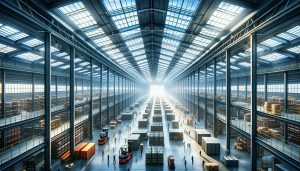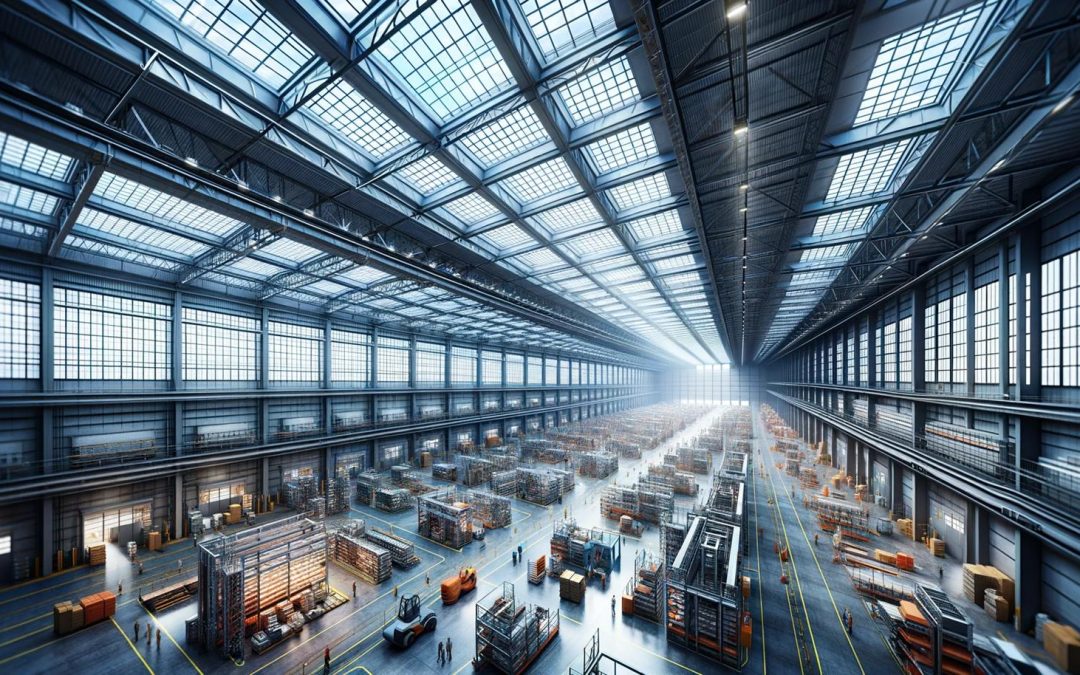In the era of searching for ecological and economical solutions in industry, skylights are a real revolution. Have you ever wondered how much the right lighting has a huge impact on work efficiency? What if I told you that there is a way to not only improve working conditions, but also reduce energy costs? Natural sunlight is the key to this, and skylights of production halls are our best ally here.
You can order high-quality polycarbonate skylights of any size from our company. See the full offer: https://www.gulajski.pl/swietliki-dachowe/ or call and ask for details: Tel/fax.: +48 (32) 236 30 05
Table of contents:
Lighting of production halls with skylights
Rooflights for production halls are a key element of modern industrial architecture, which plays an important role in the natural lighting of buildings such as production halls, warehouses and even some office areas. Their main task is to allow sunlight to penetrate into the interior, which has a number of benefits. First, they reduce energy costs by reducing dependence on artificial lighting. This ecological and economic advantage is particularly important in the context of growing environmental awareness and the need to reduce CO2 emissions.
Another key benefit of skylights is their positive impact on the well-being and productivity of employees. Studies have shown that natural sunlight can significantly improve mood and health, reducing the risk of depression and increasing energy levels. In workplaces where light beams are used, employees often feel more focused and productive.
The history of skylights is closely linked to the development of the industrial revolution. In the early stages of industrial development, large factories and warehouses were often deprived of adequate lighting, which led to difficult working conditions. The introduction of skylights was a revolutionary step towards improving these conditions. Over the years, advances in technology have allowed for the creation of more and more sophisticated skylights, which are now capable of providing even light dispersion, protection against excessive heat and minimising heat loss in winter.
Today’s industrial fanlights are designed for maximum energy efficiency and comfort. They use materials such as polycarbonate, which is both durable and translucent, as well as advanced control systems that allow you to adjust the amount of light coming in depending on your needs and the time of day. In addition, modern fanlights can be equipped with sensors and automatic adjustment systems that adapt their operation to the current weather conditions.
Rooflights are not only a key element in the design of sustainable and green workspaces, but also have a significant impact on the well-being and productivity of employees. Their development and improvement continues to be an important aspect of technological progress in industrial architecture.
Lighting of production halls with flat roof fanlights – types
The variety of skylights reflects the complexity of the architectural and functional needs of different types of buildings. Each type of fanlight is designed to meet specific requirements, both in terms of aesthetics and lighting efficiency.
| Fanlight type | Characteristics | Ideal application |
|---|---|---|
| Flat fanlights | Minimalist design, often with multi-layer glazing for better insulation. It subtly integrates with modern architecture. | Modern buildings where aesthetics is as important as functionality. |
| Dome fanlights | Made of durable, transparent materials, they ensure even light dispersion. | Industrial halls with high ceilings, requiring uniform lighting. |
Each of these types of fanlights has its own unique features and is best suited to specific architectural and functional needs. Choosing the right fanlight depends on a number of factors, including the shape and size of the roof and the specific lighting requirements of the building.
Application of skylights for roofs
The use of skylights in industry is a key element in the design of modern production halls. These specialist lighting solutions, which provide natural light to the interior, bring significant benefits in terms of both energy efficiency and environmental impact.
Impact on factory floor lighting: Rooflights are designed to maximize the use of daylight, which is especially important in large industrial spaces. They ensure that light is evenly distributed, eliminating dark zones and reducing contrast between light and shadowy areas. This, in turn, translates into better visibility and safety at work. Natural light is also less tiring for the eyes, which is important in places where employees spend many hours.
Energy and environmental benefits: From an ecological point of view, skylights significantly reduce the need for artificial lighting, which translates into lower energy consumption and carbon dioxide emissions. In an era of growing environmental awareness and the need for sustainable development, companies are increasingly using light as a way to reduce their carbon footprint. In addition, modern technologies such as intelligent light management systems allow for automatic adjustment of lighting intensity depending on the availability of external light, which further increases energy efficiency.

Examples of use in various industries: Fanlights are used in a wide range of industries. For example, in the automotive industry, where precision work requires excellent visibility, fanlights provide optimal lighting conditions. In the food industry, where hygiene and accuracy are key, natural light helps to maintain high standards of work. In the logistics sector, such as large distribution centers, skylights enable better recognition of colors and characters, which is important for efficient merchandise management.
Industrial skylights are therefore not only a tool for improving working conditions and safety, but also an important element of the environmental strategy of companies. Their growing popularity in industry is due to the combination of practical benefits with social and environmental responsibility. The use of these solutions represents a step towards sustainability and shows how technology can support both people and the planet.
How to choose and install industrial fanlights
The selection and installation of skylights is a process that requires careful consideration of a number of factors to ensure maximum efficiency and safety. The right fanlights can significantly improve the quality of lighting on the production floor, as well as contribute to reducing operating costs.
Advice on choosing skylights
- Assess lighting needs: First of all, you need to assess the specific lighting requirements of your hall. Depending on the type of work performed, different light intensity and quality may be necessary. For example, precision manual work requires brighter lighting than goods storage.
- Adaptation to the characteristics of the building: It is important that the fanlights are suitable for the shape and structure of the roof. Aspects such as the angle of the roof, its material and strength must be taken into account to ensure safe and durable installation.
- Types of fanlights: The choice between different types of fanlights, such as flat or dome, should depend on the needs of the space. Flat fanlights are often chosen for their aesthetics, while dome skylights can diffuse light better in large spaces.
Installation and maintenance issues
- Professional installation: The installation of skylights should be carried out by an experienced installer. Incorrect installation can lead to problems such as leaks, structural damage to the roof or insufficient lighting.
- Maintenance: Regular maintenance is crucial to maintaining the effectiveness of fanlights. You should regularly check their condition, clean them of dirt and snow, and monitor for any damage.
Cooperation with experienced suppliers and installers
- Supplier selection: Choosing the right fanlight supplier that offers high-quality products and a warranty is important. The supplier should be able to provide fanlights that meet your specific requirements and advise you on the best solution.
- Installers’ expertise: Experienced installers will not only ensure proper installation, but can also help you choose the right fanlights. Their knowledge and experience are invaluable in ensuring that your lighting system will function effectively and safely.
Careful selection and professional installation of skylights are key elements in ensuring effective lighting in the production hall. Working with experienced suppliers and installers ensures that this investment will bring the expected benefits, such as improved working conditions, energy efficiency and reduction of operating costs. All these services are provided by our Gulajski Company:
Adam Tomczyszyn – tel. 511 278 787
Poland: Bialystok, Bydgoszcz, Gdansk, Gorzow Wielkopolski, Katowice, Kielce, Krakow, Lublin, Lodz, Olsztyn, Opole, Poznan, Rzeszow, Zielona Gora, Przemyśl, Wroclaw
Agnieszka Dziedzic – tel. 504 496 873
Małopolska: Kraków, Nowy Sącz, Tarnów, Chrzanów, Miechów, Zakopane, Nowy Targ, Sucha Beskidzka, Wadowice, Gorlice, Olkusz, Miechów
Magdalena Krzyżyk – tel. 516 962 360
Silesia: Gliwice, Katowice, Zawada, Tarnowskie Góry, Chorzów, Ruda Śląska, Rybnik, Pyskowice, Knurów, Żory, Piekary Śląskie, Sosnowiec, Dąbrowa Górnicza.
Lower Silesia: Wrocław, Legnica, Wałbrzych, Jelenia Góra, Głogów, Kłodzko, Zgorzelec
The future of skylights in production halls
The future of skylights seems bright and full of innovation, especially in the context of the growing demand for sustainable building solutions. The development of skylight technology is closely linked to trends in energy efficiency, ecology and intelligent building technologies.
In the future, skylights are likely to use even more advanced materials and technologies. We can expect the development of fanlights with better thermal and acoustic insulation, which will allow for additional energy savings and improve the comfort of using buildings. Also, the development of self-cleaning and scratch-resistant materials will ensure a longer service life and lower maintenance costs.
Autor: Tomasz Matuszek; Dział Marketingu - Firma Gulajski

